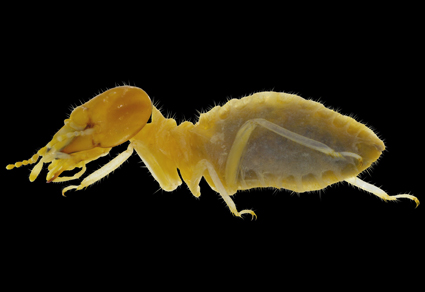Abstract
Soldierless termites of the Apicotermitinae remain one of the least studied groups in termite taxonomy, particularly within the Amazon Rainforest, a biodiversity hotspot. This study introduces Tucupitermes ubixaba Almeida-Azevedo, Acioli & Azevedo gen. et sp. nov., the largest Apicotermitinae in the Amazon Rainforest and a new monotypic genus distinguished by unique morphological traits, including an elongated stomodeal valve, Malpighian ampullae developed, a long mesenteric tongue, and small bilobed seating. These features were documented through detailed analyses of the external and internal morphology of the worker caste. The discovery of this genus not only fills a critical gap in the taxonomy of Apicotermitinae but also provides new insights into the diversity and ecological adaptations of soldierless termites in the Amazon.
References
- Acioli, A.N.S. & Constantino, R. (2015) A taxonomic revision of the neotropical termite genus Ruptitermes (Isoptera, Termitidae, Apicotermitinae). Zootaxa, 4032 (5), 451–492. https://doi.org/10.11646/zootaxa.4032.5.1
- Ackerman, I.L., Constantino, R., Gauch, H., Lehmann, J., Riha, J.S. & Fernandes, M. (2009) Termite (Insecta: Isoptera) species composition i a primary Rain Florest and agroforests in Central Amazonia. Biotropica, 41 (2), 226–233. https://doi.org/10.1111/j.1744-7429.2008.00479.x
- Almeida-Azevedo, R., Alves-Oliveira, J., Morais, J.W., Franklin, E. & Azevedo, R.A.D. (2023) Step-by-step Dissection Protocol of Apicotermitinae Worker (Blattaria: Isoptera). Sociobiology, 70 (4), e8503. https://doi.org/10.13102/sociobiology.v70i4.8503
- Almeida-Azevedo, R., Acioli, A.N.S., Morais, J.W.D. & Azevedo, R.A.D. (2023) Caputitermes, a new genus of soldierless termite (Blattaria: Isoptera: Termitidae) with dimorphic workers from the Amazon rainforest. Acta Amazonica, 53 (3), 201–207. https://doi.org/10.1590/1809-4392202202511
- Barsotti, R.C. & Costa-Leonardo, A.M. (2000) Morfologia do tubo digestivo nos cupins Heterotermes tenuis (Hagen) e Coptotermes havilandi Holmgren (Isoptera, Rhinotermitidae). Revista Brasileira de Zoologia, 17, 205–212.
- Bourguignon, T., Šobotník, J., Dahlsjö, C.A.L. & Roisin, Y. (2016) The soldierless Apicotermitinae: insights into a poorly known and ecologically dominant tropical taxon. Insectes Sociaux, 63, 39–50. https://doi.org/10.1007/s00040-015-0446-y
- Bourguignon, T., Scheffrahn, R.H., Krecek, J., Nagy, Z.T., Sonet, G. & Roisin, Y. (2010) Towards a revision of the Neotropical soldierless termites (Isoptera: Termitidae): redescription of the genus Anoplotermes and description of Longustitermes, gen. nov. Invertebrate Systematics, 24, 357–370. https://doi.org/10.1071/IS10012
- Burmeister, H. (1839) Termiten, weisse Ameisen. Termitina. In: Burmeister, H. (Ed.), Handbuch der Entomologie. Vol. 2. Theod. Chr. Friedr. Enslin, Berlin, pp. 758–768.
- Carrijo, T.F., Castro, D., Wang, M., Constantini, J.P., Bourguignon, T., Cancello, E.M., Roisin, Y. & Scheffrahn, R.H. (2023) Diminishing the taxonomic gap in the neotropical soldierless termites: descriptions of four new genera and a new Anoplotermes species (Isoptera, Termitidae, Apicotermitinae). ZooKeys, 1167, 317–352.
- Donovan, S.E. (2002) A morphological study of the enteric valves of the Afrotropical Apicotermitinae (Isoptera: Termitidae). Journal of Natural History, 36, 1823–1840. https://doi.org/10.1080/00222930110062309
- Emerson, A.E. (1925) The termites of Kartabo, Bartica District, British Guiana. Zoologica, 6 (4), 291–459.
- Fontes, L.R. (1986) Two new genera of soldierless Apicotermitinae from the Neotropical region. Sociobiology, 12, 285–297.
- Fontes, L.R. (1987) Morphology of the alate and worker mandibles of the soil-feeding nasute termites (Isoptera, Termitidae, Nasutitermitinae) from the Neotropical Region. Revista Brasileira de Zoologia, 3, 503–531. https://doi.org/10.1590/S0101-81751986000400003
- Fontes, L.R. (1998) Novos aditamentos ao “Catálogo dos Isoptera do Novo Mundo,” e uma filogenia para os gêneros neotropicais de Nasutitermitinae. In: Fontes, L.R. (Ed.), Cupins: o desafio do conhecimento. Fundação de Estudos Agrários Luiz de Queiroz, São Paulo, pp. 309–412.
- Jouquet, P., Traoré, S., Choosai, C., Hartmann, C. & Bignell, D. (2011) Influence of térmites on ecosystem functioning. Ecosystem services provided by termites. European Journal of Soil Biology, 47, 215–222. https://doi.org/10.1016/j.ejsobi.2011.05.005
- Mathews, A.G.A. (1977) Studies on Termites from the Mato Grosso State, Brazil. Academia Brasileira de Ciências, Rio de Janeiro, 267 pp.
- Müller, F. (1873) Beiträge zur Kenntniss der Termiten. Jenaische Zeitschrift für Medizin und Naturwissenschaft, 7 (3), 333–358, pls. 451–463.
- Noirot, C. (1995) The Gut of Termites (Isoptera). Comparative Anatomy, Systematics, Phylogeny. I. Lower Termites. Annales de La Société Entomologique de France, 31 (3), 197–226. https://doi.org/10.1080/21686351.1995.12278468
- Noirot, C. (2001) The gut of termites (Isoptera) comparative anatomy, systematics, phylogeny. II. Higher termites (Termitidae). Annales de la Société Entomologique de France, 37, 431–471.
- Pinzón Florian, O., Scheffrahn, R.H. & Carrijo, T.F. (2019) Aparatermes thornatus (Isoptera: Termitidae: Apicotermitinae), a new species of soldierless termite from northern Amazonia. Florida Entomologist, 102 (1), 141–146. https://doi.org/10.1653/024.102.0123
- Romero Arias, J.R., Chevalier, C. & Roisin, Y. (2020) Anatomical specializations of the gizzard in soil-feeding térmites (Termitidae, Apicotermitinae): Taxonomical and functional implications. Arthropod Structure and Development, 57, 100942. https://doi.org/10.1016/j.asd.2020.100942
- Roonwal, M.L. (1970) Measurement of termites (Isoptera) for taxonomic purposes. Journal of the Zoological Society of India, 21, 9–66.
- Scheffrahn, R.H., Carrijo, T.F., Postle, A.C. & Tonini, F. (2017) Disjunctitermes insularis, a new soldierless termite genus and species (Isoptera, Termitidae, Apicotermitinae) from Guadeloupe and Peru. ZooKeys, 665, 71–84. https://doi.org/10.3897/zookeys.665.11599
- Silvestri, F. (1901) Nota preliminare sui Termitidi sud-americani. Bollettino dei Musei di Zoologia ed Anatomia Comparata della Reale Università di Torino, 16 (389), 1–8.
- Šobotník, J., Sillam-Dussès, D., Weyda, F., Dejean, A., Roisin, Y., Hanus, R. & Bourguignon, T. (2010) The frontal gland in workers of Neotropical soldierless termites. Naturwissenschaften, 97, 495–503. https://doi.org/10.1007/s00114-010-0664-0


